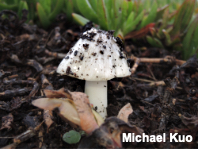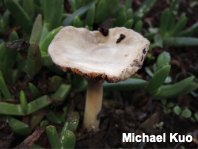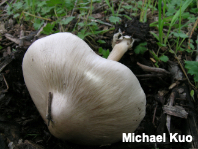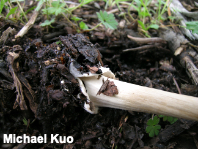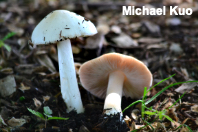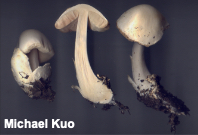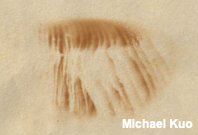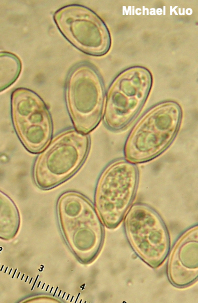| Major Groups > Gilled Mushrooms > Pink-Spored > Volvariella and Volvopluteus > Volvopluteus gloiocephalus |

|
Volvopluteus gloiocephalus [ Basidiomycota > Agaricales > Pluteaceae > Volvopluteus . . . ] by Michael Kuo Usually found in urban settings or in rural places where humans have left their mark, Volvopluteus gloiocephalus is a fairly large mushroom with a sticky-when-fresh cap, pink mature gills, and a cup-like volva around the base of its stem. It grows terrestrially in grass, on beaches, in landscaping, on woodchips, and so on—but not, generally, from logs or trees. Some species of Amanita can appear similar, but a spore print will sort out confusion quickly: amanitas have white spore prints, while the spore print of Volvopluteus gloiocephalus is pink. By current definitions, the cap color of Volvopluteus gloiocephalus is variable, ranging from gray to white. White-capped versions had previously been separated as "Volvariella speciosa," but according to several authors (e.g. Shaffer 1957, Boekhout & Enderle 1996) both color forms have been found arising from the same mycelium. I am not so sure. I have collected Volvopluteus gloiocephalus many times in California, where it is always grayish and streaked (even when it appears whitish from a distance, close inspection reveals grayish radiating streaks and appressed fibrils). In the Midwest, however, my collections have been pure white (before discoloring with age), without a hint of gray. Additionally, my Midwestern collections all feature predominantly rostrate cystidia, while cystidia of my California collections are only rarely rostrate. In short, as Justo and collaborators write (2011a), "[e]xamination of additional collections of all taxa of Volvopluteus is still needed to establish more precisely the morphological limits of the species." Volvariella gloiocephala and Volvariella speciosa are synonyms. Description: Ecology: Saprobic; growing terrestrially, alone or gregariously in urban settings and disturbed ground (landscaping, ditches, beaches, lawns, gardens, and so on)—and, east of the Rocky Mountains, sometimes in forests; found year-round, depending on the climate; widely distributed in North America, though some records of it from east of the Rocky Mountains may represent other similar species, including the smaller-spored Volvopluteus michiganensis. The illustrated and described collections are from California and Illinois. Cap: 5–10 cm across; convex becoming broadly convex, broadly bell-shaped, or nearly flat; sticky when fresh and young but often soon dry; bald; color variable (see discussion above), white to grayish or gray, discoloring brownish to yellowish with age; when gray, with a radially streaked, appressed-fibrillose appearance; the margin sometimes finely lined. Gills: Free from the stem; close or nearly crowded; short-gills frequent; white at first, becoming brownish pink with maturity. Stem: 6–13 cm long; 1–2 cm thick; tapered to apex; base slightly swollen; dry; bald or finely silky; white, discoloring brownish; without a ring; the base encased in a white, cup-like volva; basal mycelium white. Flesh: White; not changing when sliced. Odor and Taste: Not distinctive, or a little foul. Chemical Reactions: KOH negative on cap surface. Spore Print: Brownish pink. Microscopic Features: Spores 13–19 x 7–10 µm; ellipsoid; thick-walled; smooth; hyaline to yellowish in KOH. Basidia 4-sterigmate. Cheilocystidia and pleurocystidia 50–80 x 20–40 µm; widely lageniform, widely cylindric with a rounded apex, subsaccate, or sphaeropedunculate; sometimes mucronate or rostrate (see discussion above); smooth; hyaline in KOH. Pileipellis a cutis of elements 5–12.5 µm wide, smooth, hyaline in KOH, under a very thin gelatinous matrix. Clamp connections not found. REFERENCES: (de Candolle, 1815) Vizzini, Contu & Justo, 2011. (Kauffman, 1918; Coker, 1947; Shaffer 1957; Smith, Smith & Weber, 1979; Arora, 1986; Boekhout, 1990; Lincoff, 1992; Horn, Kay & Abel, 1993; Boekhout & Enderle, 1996; McNeil, 2006; Miller & Miller, 2006; Justo & Castro, 2010; Justo et al., 2011a; Justo et al., 2011b; Kuo & Methven, 2014; Desjardin, Wood & Stevens, 2015; Siegel & Schwarz, 2016.) Herb. Kuo 05280201, 01160602, 06081401, 01151501, 01111801, 01141806. This site contains no information about the edibility or toxicity of mushrooms. |
© MushroomExpert.Com |
|
Cite this page as: Kuo, M. (2018, December). Volvopluteus gloiocephalus. Retrieved from the MushroomExpert.Com Web site: http://www.mushroomexpert.com/volvopluteus_gloiocephalus.html |
